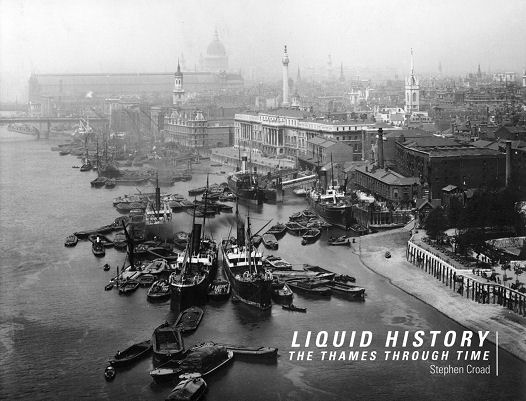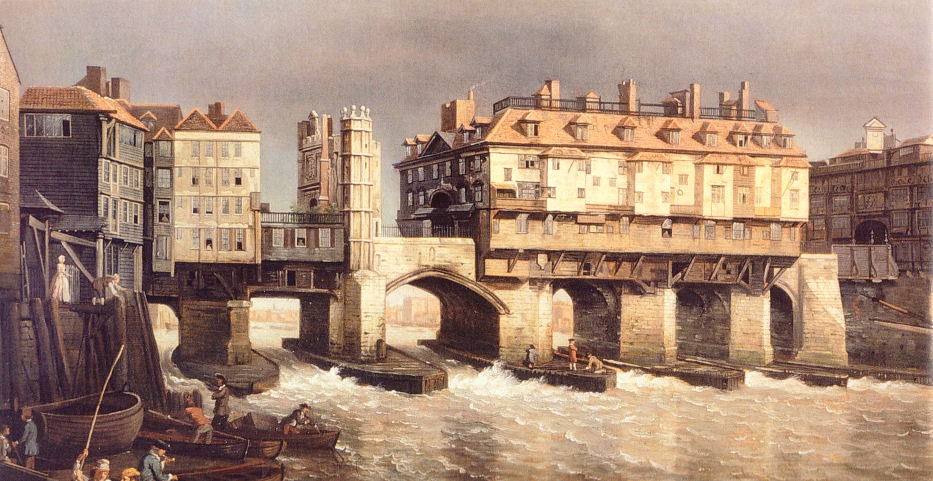

 |
![]()

 |
Stephen Croad
Liquid history The Thames through time Batsford 2003 A photographic survey of the Thames, from the source to the wind-blown marshes at the mouth, using old photos mostly, but with some newer views. It's fascinating stuff, well and fully captioned, with plenty of evocative shots of ramshackle riverside squalor and the old docks and barges. The considerable narrowing of the river by the construction of the embankment can be appreciated in before and after photos of Somerset House. And the Port of London photograph used on the cover is as good view of pre-Hitler and pre-tower-block London as you could hope for. |
|
|
|
||
|
Nicholas Waldemar Brown & Graham Reed London's Waterfront: The Thames from Battersea to the Barrier Burke's Peerage and Gentry 2003 This is an annotated panorama similar to such books about the Grand Canal, but the Thames is a much longer waterway so this is a much narrower and wider representation. It's also in the form of architect-style drawings, taken from photos the introduction says, with the full-colour petering out somewhat in the less important stretches, but at least these relatively unglamorous bits are dealt with. It's an oddly mixed book to actually read as it's part gift-book but also quite informative. I can't quite cast off the suspicion that this is partly published with the intention of appealing to businesses, and rich people, who want to show off their riverside properties in print. (The fact that the publisher's website provides an A-Z of the buildings in the book somewhat confirms this suspicion.) The text is mostly good enough, and sometimes quite quirky, but also sometimes gives the impression of being copied from corporate brochures. An attractive book that combines smiles with frowns, then. |
||
|
Ian Currie  Frosts, Freezes and Fairs Chronicles of the frozen Thames and harsh Winters in Britain since 1000AD Frosted Earth 1996 A good half of meteorologist Currie's book is taken up with A Chronology of Famous Freezes from AD 1000, detailing the bad-weather years in idiosyncratic detail. The rest of the book deals with the three great Frost Fair winters of 1683/4, 1739/40 and 1814, when the Thames froze over and much merry was made. John Evelyn wrote, in his diary, that there was Bull-baiting, Horse and Coach races, Pupet-plays and interludes, Cookes and Tipling, and lewder places; so as it seem'd to be a bacchanalia, Triumph or Carnoval on the water. Booths were set up selling the likes of brandy balls, ginger breads, black puddings, plum cakes, pancakes and glasses of 'mum': hot ale with spices and wine and added unspecified ingredients. And folk do tipple without fear to sink/More liquor than the fish beneath do drink. Printing presses were popular too, selling certificates and poems commemorating the novelty of printing on the Thames, with the purchaser's name and the date attached, for six-pence. The final Frost Fair of 1814 followed one of the worst of the famed fogs, the 'London particulars', at the end of 1813. When the persistent and fatal frost that followed began to melt the ice floes became congested between the Old London and Blackfriars Bridges. The lumpy landscape of slabs solidified on the 1st of February, and by the 3rd there was a carnival of booths, streamers, flags - all the more spectacular at night as the stars and fires sparkled from the ice with St Paul's in the background. There was much gambling, dancing, drinking and the peddling of over-priced souvenirs before the great thaw. This again drew the crowds to watch the passing of great and small icebergs, the wrecks of lighters and barges, and even chunks of bridge smashed by the floes. The Thames now flows too fast for frost fairs, because the embankments are smoother, tributaries like the Fleet have been confined to underground culverts, and the space between the spans of the bridges, especially since the demolition of the Old London Bridge, are wider. And the City can be as much as 10F warmer at night than the rest of Greater London, as the day's heat is stored in its stones. A fascinating phenomenon and an interesting, if slightly dry, read. |
||
|
|
Patrick Wright
The River - The Thames in Our Time BBC 1999 This book accompanies a BBC TV series which passed me by completely, unfortunately. It takes us up and down the River, beginning with tales from the Estuary, of eccentrics and idealists and fatal mists, and ending in the pre-millennially supremely symbolic area of Docklands and the Dome. Wright's is a human, and therefore broadly socialist, take on the characters and constructions he encounters. A view familiar to fans of 'A Journey through the Ruins', his book about inner city life in post-war Britain, springing from his observations on tower-block life in Dalston in East London, very near my place of birth. There is much more social and topical than topographical observation here, and he covers much fascinating ground. He's happier and more interesting dealing with the immigrants and ex-East Enders at the Estuary end than the toffs nearer the source, but this is easy to read and hard to beat as a contemporary look at life along the Thames. |
|
|
|
||
 Dorian Gerhold London Bridge and its Houses c.1209-1761 London Topographical Society 2019 This is a book about London Bridge during the time when it was a street of houses and shops, with a palace and a church. It has all the lovely illustrations you could wish for, and more information, probably, than you'll ever need. There are plenty of plans, maps, charts, reconstruction drawings and cutaways, and even a foldout, but only the one. You can read the history, find out who lived where, and who sold what, and when. (For several years there were a few spurriers doing business. They made spurs, dontcha know.) To see this book is to want to buy it, in short, but chances are you won't be able to do either, as it was so popular it sold out in mere months. But the publisher is not looking to reprint it as 'the costings of such an exercise proved prohibitive'. If this confounds your understanding of how capitalism works, join the club! |
||